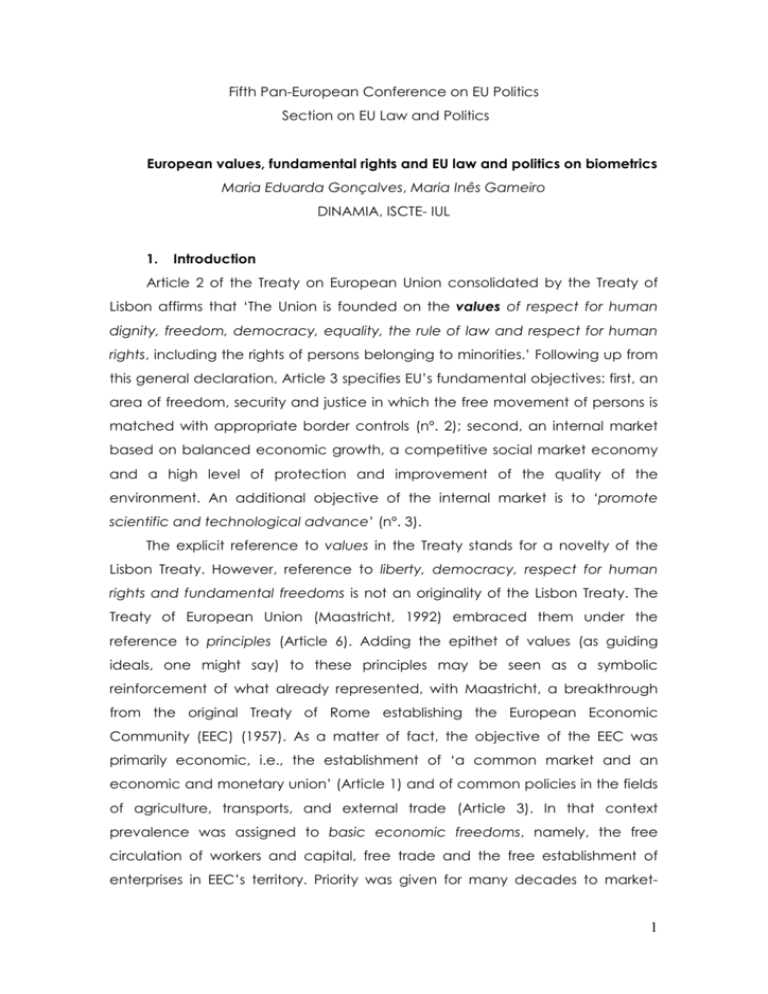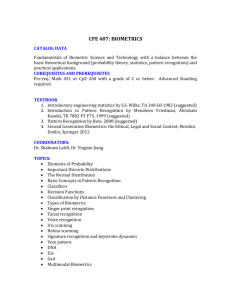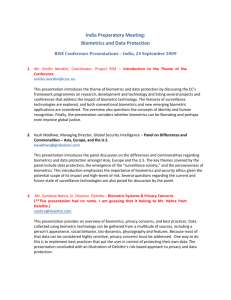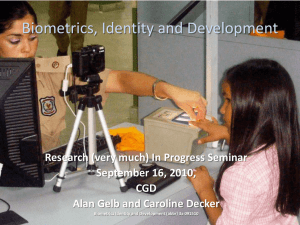European values, fundamental rights and EU law and politics
advertisement

Fifth Pan-European Conference on EU Politics Section on EU Law and Politics European values, fundamental rights and EU law and politics on biometrics Maria Eduarda Gonçalves, Maria Inês Gameiro DINAMIA, ISCTE- IUL 1. Introduction Article 2 of the Treaty on European Union consolidated by the Treaty of Lisbon affirms that ‘The Union is founded on the values of respect for human dignity, freedom, democracy, equality, the rule of law and respect for human rights, including the rights of persons belonging to minorities.’ Following up from this general declaration, Article 3 specifies EU’s fundamental objectives: first, an area of freedom, security and justice in which the free movement of persons is matched with appropriate border controls (nº. 2); second, an internal market based on balanced economic growth, a competitive social market economy and a high level of protection and improvement of the quality of the environment. An additional objective of the internal market is to ‘promote scientific and technological advance’ (nº. 3). The explicit reference to values in the Treaty stands for a novelty of the Lisbon Treaty. However, reference to liberty, democracy, respect for human rights and fundamental freedoms is not an originality of the Lisbon Treaty. The Treaty of European Union (Maastricht, 1992) embraced them under the reference to principles (Article 6). Adding the epithet of values (as guiding ideals, one might say) to these principles may be seen as a symbolic reinforcement of what already represented, with Maastricht, a breakthrough from the original Treaty of Rome establishing the European Economic Community (EEC) (1957). As a matter of fact, the objective of the EEC was primarily economic, i.e., the establishment of ‘a common market and an economic and monetary union’ (Article 1) and of common policies in the fields of agriculture, transports, and external trade (Article 3). In that context prevalence was assigned to basic economic freedoms, namely, the free circulation of workers and capital, free trade and the free establishment of enterprises in EEC’s territory. Priority was given for many decades to market- 1 based objectives as shown, in particular, by the primacy of market ‘freedoms’ in the European Court of Justice’s case-law. 1 2 Even after the entering into force of the Treaty of the European Union, in 1992, the scope of civil and political rights in the Treaty remained confined to European citizenship involving the rights to freedom to move and to reside within the territories of the member states (Article 2) and to participate in municipal elections in their member state of residence (Article 18). Only lately, following the failed attempt to adopt a European Constitution and the subsequent adoption of the Treaty of Lisbon (2009) the way was paved for a true focus of EU political and legal discourse on human values. It is in this context that the Charter of Fundamental Rights of the EU was brought into life with binding force, even if not incorporated in the Treaty of Lisbon (Article 6 TEU). No doubt, the Charter and the Treaty of Lisbon now offer a prime setting for the expression of the most prized values of Europe, meaning of course the European Union. Yet, while the adoption of the Charter with binding force should direct EU institutions in the design of law and policy, the question remains of how such effect will work in practice. A domain falling under the EU’s scope of responsibility in which respect for the Charter’s values and principles is in this day and age especially critical is surely science and technology. Scientific and technological advance, as already pointed out, was proclaimed by the TEU as a key goal of the internal market. In turn, the Charter of Fundamental Rights states the EU intent ‘to strengthen the protection of fundamental rights in the light of changes in society, social progress and scientific and technological developments by making those rights more visible in a Charter.’ New scientific and technological advances such as inter alia genetically modified organisms, nanotechnologies, See Curzon, 2009, p. 110 and 116, acknowledging the tendency of the ECJ to ‘subordinate fundamental rights protection to the protection of fundamental economic freedoms’, possibly related to the ‘unbreakable bond between the European Court of Justice and the founding treaties which created it’. According to this author, even as it developed, timidly and slowly, protection of fundamental rights by the ECJ continued to be perceived as an exception to the general rule of market’s fundamental freedoms (Curzon 2009, p. 122). 2 In the EU context, human rights are most often referred to as ‘fundamental rights.’ No major conceptual difference is involved, and the terms will be used interchangeably in this report. The distinction between fundamental (human) rights (not listed in the Treaties) and fundamental (economic) freedoms (listed in the Treaties) is relevant, however. Some consider the economic freedoms to be human rights, but that is not the generally accepted view, see Bogdandy 2000, p. 1326. 1 2 animal and human cloning, or security technologies have a bearing on moral and ethical values perceived by European societies as fundamental, including human dignity and integrity, as well as values typical of the contemporary postindustrial society such as environmental protection and consumer safety. All these values find expression in the Charter of Fundamental Rights in the form of fundamental principles or rights. It should also be recalled that, notwithstanding their equivalent status as principles of law and/or human rights, several of such principles and rights are amenable to collide with each other in theory as well as in concrete instances. Indeed, conflict or clash of rights is a familiar notion to the law, as is the proportionality principle that seeks to address this conflict (Tsakyrakis 2008). It seems, therefore, reasonable to ask how the new EU rhetoric focusing on human values and rights might shape the legal and regulatory frameworks for scientific research and technological applications by looking at how the underlying balances of conflicting values, principles and rights have been addressed in the recent past. The Charter has by now been regarded as an effort to make human rights ‘determine’ rather than simply ‘limit’ an EU legal system predominantly designed to guarantee market freedoms, implying a demand to the legislator and judiciary to ‘tilting the balance between regulatory policies and individual freedoms in favour of the latter’ (von Bodgandy 2000, p. 1321). It has also been argued, a process mirroring the construction of the internal market may be in the making for fundamental human rights: from ‘negative’ rights and freedoms implying the prohibition or limitation of certain acts to ‘positive’ rights and freedoms, in other words, ‘a comprehensive, coherent, balanced and forwardlooking human rights policy’ (Alston and Weiler 1999, p. 8). Is this aim mere wishful thinking? To what extent is it being pursued, one might ask? Against this backdrop, this paper aims to critically appraise how human or social values rendered explicit through the Charter’s principles and rights are being balanced against the promotion of scientific and technological advance. This appraisal will be based on the current EU legal framework for biometrics, a new security technology whose development is being supported under the EU Research and Development (R&D) policy, and is employed mainly 3 for individual and social surveillance purposes. Biometrics elicits complex ethical and legal challenges that have been addressed by European law lately. The selection of this technology for the purposes of the present analysis lay on two main interrelated criteria: its controversial or contested nature that we take as an indicator of social sensitivity or anxiety in that regard; and the extent to which it raises moral or ethical dilemma around basic values such as human dignity, individual autonomy, liberty or privacy. Our assumption is that the present state of affairs in the EU, where the design to promote scientific and technological progress goes alongside growing public fears about both ethical and social issues and potential adverse impacts of science and technology, underlines the need for a value-oriented framework for scientific and technological development and a value-based governance of science and technology. This paper will start by clarifying the key relevant concepts, values, principles and rights. Legal principles and human rights will provide the main entry points for our review of values in EU S&T law and regulation in respect of biometrics, to be ascertained from a reading of the EU Charter on Fundamental Rights. This preliminary review aims to identify the values at issue, and how they relate or collide with each other: for example, Article 3 (Right to the integrity of human being) and the specific restrictions applicable to the fields of medicine and biology contained in the same article (e.g., the free and informed consent of the person concerned or the prohibition on making the human body and its parts as such a source of financial gain) may interfere with the freedom of the sciences guaranteed by Article 13; similarly, Article 8 on the right to protection of personal data may conflict with Article 16 on the right to conduct a business (or right to free enterprise). This right can be regarded as the legal background for technological and industrial innovation. The ways in which EU law and regulation are tackling these principles and rights, in theory and in practice, will be discussed in the light of the selected case study. 2. Values, legal principles and rights Values understood as standards of morality or justice and/or ends or ideals to be pursued enter the law through legal principles and legal rights. Many 4 norms are or can be justified by values or high substantial principles such as justice or human rights. Values, it has been suggested, may be approached through two consecutive steps: first, a reflection about values and, second, the definition of norms referring to those values and leading to rules, including legal rules (Mache 2006, p.34). Although values, principles and rules have been for a long time immersed in ‘confusion and controversy’ (Alexy 2010, p. 45), broadly speaking, law is essentially shaped by values: on a more general and abstract level, by law’s intrinsic values of justice, equality and security, and on a more applied level by those that are codified through the choices of the legislator in each domain of policy or regulation. The former tend to be universal while the latter are evolving and changing, framed by a society undergoing permanent processes of adjustment, nowadays, in particular, to a ‘new relationship between the law, science and technology’ (Morin 2004, p. 94). Values generally lead to principles translating into rights and from these to rules and regulatory instruments in a ‘series of interlocking definitions and distinctions’ (Dworkin 1977, p. 18). Such a ‘legal cascade’ thus flows from normative principles to ordinary law and case-law, as well as to soft-law instruments such as codes of conduct. Attention should be drawn to the fact that there is no rigid legal order hierarchy any longer. Different layers of principles and norms interrelate and influence each other. The general principles of law, especially those widely accepted by the EU and inserted in the Charter of Fundamental Rights, provide an illustration of this interaction (Haberle 2003, p. 127). In sum, law should be understood nowadays as more than a collection of rules of conduct imposed by the legislator and judges’ adjudication in the classic positivist definition. Particularly in the field of science and society the legal system involves a rising number of soft-law instruments, participatory mechanisms and advisory committees and panels. 3 Yet, the definition of legal principles and legal rights is not always easy to make. Dworkin argued that principles are standards to be observed because they constitute requirements of ‘justice or fairness or some other dimension of Accordingly, the notion of law used in this report will encompass both binding legal instruments of European law, i.e. regulations and directives of the European Council and the European Parliament and decisions of EU institutions; and soft law that is not formally binding and may emanated both from EU institutions and self-regulatory entities, for example, professionally-based codes of conduct. 3 5 morality’ (Dworkin 1977, p. 22). Habermas observed that while legal principles ‘have a deontological sense’, values that are embraced by the law are teleological (Habermas 1996, p. 255). In turn, Alexy defined principles as ‘norms commanding that something must be realized to the highest degree that is actually and legally possible’ (Alexy 1992, p. 145). Thus, the most obvious distinctive feature of a legal principle is its ‘juridical’ quality, opposing a merely ethical or social one, meaning that it must be included in a legal norm. Legal principles, also conceptualised by some legal positivists as imperfect norms, provide general normative guidelines to be developed through legal norms, properly speaking (Zagrebelsky 2002, p. 870). Thus, both principles and norms are more or less general instructions with respect to expected behaviour of defined groups or the expected performance of a specific activity. A deeply interrelated concept with that of legal principles is that of legal rights. Legal rights can be construed as freedoms to act or refrain from acting or entitlements to be acted upon or not acted upon that are provided by law. As societies become more complex, more and more rights, including freedoms, translate into obligations addressed to states or to third parties to ensure that their content is fulfilled. Hence both principles and rights as normative and authoritative statements translate particular values into goals for the legal order to achieve. The EU Charter on Fundamental Rights offers a paradigmatic example of a human rights protection system that combines principles and rights (including freedoms). The singling out of principles and rights in the Charter can easily be ascertained from a simple reading. 4 Indeed, one may generally accept that when the Charter declares that specific values should be protected or specific goals should be pursued 5 , it is asserting a principle, whereas when the individual is referred to by the Charter a right is being stated6 (Soares 2002, p. 69). Article 51/1 of the Charter, according to which EU institutions and Member States shall ‘respect the rights’ and ‘observe the principles’, while not differentiating these concepts neatly, renders clear the common responsibility of public authorities ‘to promote the application’ of both Examples are Article 13, ‘The arts and scientific research shall be free of constraint’, and Article 37, ‘A high level of environmental protection and the improvement of the quality of the environment must be integrated into the policies of the Union and ensured in accordance with the principle of sustainable development’. 4 6 principles and rights. Further clarification comes out from the Explanations of the Charter (EU 2007b). According to this document, principles may be implemented through legislative or executive acts, and shape the ECJ and national court’s interpretation or review of those acts. However, they contrast with rights since they do not ‘give rise to direct claims for positive action by the Union's institutions or Member States authorities’. This distinction should not be meant to imply that principles are weaker since European institutions are required to comply with such principles and can even be judicially responsible for not complying with them. For the purposes of the present analysis, an additional distinction should be taken into account: law and regulation. While law can be identified with general and fundamental principles and rights, regulation is meant to be control exercised by a public agency over activities that are valued by a community. Public regulation involves policy choices and in that sense it represents a ‘materialization of the law’ (Habermas 1986). As indicated above, the legal order develops in a gradual manner from the initial generic framework set by principles and rights, normally stated in treaties and constitutions, progressively narrowed to public regulation. As pointed out already, regulatory institutions and procedures, e.g. for licensing or authorisation, and monitoring of certain economic or social activities, and the way regulatory competencies and powers are distributed among public bodies and other entities, both national and participative European, mechanisms, including may the provision facilitate or of consultative otherwise constrain and the receptiveness of the regulatory system to values as they are perceived in or by society. Hence, while assessing the translation of values into European law and regulation attention should be paid to the channels opened by law for stakeholders and civil society to have a say in the regulatory process and by this means expressing ‘their’ most-prized values and ultimately shaping the value system brought into law or regulation. To what extent are there ‘platforms of dialogue on values’, as recommended by the European Commission (EC 2005, p. 20)? 3. Values in European law addressing biometrics 7 As pointed out already, principles and rights provide us with the main doorways for acceding to values embedded in the law. Principles play a critical role in respect of emerging sciences and technologies since they can more easily accommodate the dynamics of scientific and technological progress. Since the protection of individual or groups’ rights is carried out through principles and norms that are likely to limit or constrain scientific activities or the development or employment of technology, there is scope for conflict between the interests or rights of S&T developers and users and those of individuals or society. The EU legislator often seeks to balance these opposing interests and rights, namely, research and technological development understood as an interest of the EU and the rights of individuals or citizens. Often, this contradiction is presented as opposing ethical to market values. But the issue is more complex than that. The freedom of research, for example, may be regarded as a component of the fundamental freedoms of thought and of speech; yet, it may also be related with free enterprise. Against this background, which values are being summoned by European law and regulation shaping the development and deployment of biometrics? Beyond the general provisions of the Charter of Fundamental Rights, how are the relevant conflicting principles and rights being tackled by EU regulation? And what does that tell us about the ‘value system’ embedded in European law on science and technology (S&T) more generally? Biometrics is a technique that relies on human characteristics to verify the identity of an individual. Face features, fingerprints, hand impressions, iris recognition or DNA are such physiological features that can be used in biometrics. Biometric technology can thus be defined as identifying individuals by using their biological or behavioural characteristics 7 . Lately biometric technology turned out to be one of the central pieces of national and international security and immigration policies in Europe and is becoming also increasingly important economically as it is more and more employed to control access of workers, students, and other categories of people in various organisations (IPTS 2005, pp. 80-87). This technology rose to the centre of techno-juridical and techno-political debates of our era following the Physiological and behavioural characteristics (voice, signature, etc.) are sometimes differentiated as biometrical indicators, but the distinction is not a peaceful one. 7 8 ‘9/11’ when security measures became more tightened worldwide approaching the idea of a ‘maximum security society’ (Marx 1988) 8 . Liberty, security and privacy are the most obvious values challenged by biometrics. But others are at stake as well, namely dignity and democracy. In fact, alongside the growing use of biometrics, concerns about civil liberties and the values underneath have amplified. The dichotomy between security, on one hand, and freedom, privacy and even human dignity, on the other, as well as the classic and broader confrontation between security and democracy came up in that connection. As a matter of fact, the growing use of information and surveillance technologies brings about a higher degree of complexity of value conflicts, and maybe even novel value conflicts. According to De Hert (2005, p. 38), ‘there is a need to establish both common principles and language of privacy for biometrics, including principles such as equality of access to the network; absolute accuracy of targeting by surveillance systems; systems to ensure the accuracy of the data held within the surveillance systems; mechanisms for making good the bad, inaccurate or changed data; systems to protect individuals from their inclination to trade their own privacy’. Some authors have called attention to a maybe upcoming ‘surveillance society’ largely nurtured by unawareness of citizens themselves about the corresponding risks (Marx 2008). They fear that the current legal system may give too much leeway to new technological developments incepted without proper interrogation from and altering to a human rights perspective. When collecting biometrical data, the physical integrity of the subject should be secured against any harm, it has also been argued. Beyond privacy, intimacy and the emotional integrity of the person together with the dignity and respect for the person’s ‘decorum’ need to be considered as well (CNPD 2004, p. 2). Biometric characteristics represent a part of people’s individuality and are intimately linked to the persons themselves (CNPD 2004, p. 1). Hence the values interfered with by biometrics can be divided in two sets: security and related rights, on the one hand, and liberty, privacy, intimacy and This comes out from a number of EU documents such as the proposal of September 2003 on a uniform format for visas and residence permits and the proposal of February 2004 for a regulation on biometrics in EU citizens’ passports, COM(2004) 116 final. However, it has also been pointed out that the 9/11 justification fails partly since most of the terrorists travel with their own valid passports (Hornung 2007, p. 259). 8 9 related rights (namely, data protection), on the other. The right to conduct a business and the freedom of research also play a part in the biometrics’ ‘rights balance’ to the extent that development and economic investment in biometric technologies are recognised as legitimate rights. However, the official European stance on this complex matter rests on the assumption that security and civil liberties can be easily compared and conciliated (Liberatore 2007, p. 114). The argument has also been built around the idea that biometrics can be used to guarantee privacy (when used to reduce the access of a room or a computer through a fingerprint recognition technique to a single person for instance) countering the idea ‘more security, less privacy’ (Hornung 2007, p. 249). Also ‘privacy and data protection should not be characterised as a zero sum gain where an individual gain means a societal loss or vice-versa’, it is stated in a report published by the EC (Robinson et al. 2009, p. 16). This idea has been underlined in other policy documents reflecting the European perspective: opposing an individual value such as liberty against a rather more community-oriented value such as security does not necessarily mean that an individual value is being sacrificed in the name of the society – in fact, instead of a ‘zero sum game’ the official description points to a ‘win-win’ situation. This understanding has reminiscences with the theoretical approach considering rights and policies to be, not exclusive, the first concerning the individual and the second society (Dworkin 2002, p. 23), but interchangeable concepts instead (Atienza 1991, p. 106). Decision Nº 1982/2006/EC approving the 7th Framework Programme on Research and Development follows the same line of reasoning when it states that ‘security in Europe is a precondition of prosperity and freedom’ 9 . In fact, the EU is actively promoting biometrics and other security technologies as part of EU research and development policy. Article 6 of the Charter of Fundamental Rights goes even further in this conciliatory move since it addresses liberty and security as part of a unique right. But why have liberty and security been treated in an integrated manner in the Charter? Should they be regarded as the two faces of the same coin or rather as conflicting principles or rights? 10 Decision Nº 1982/2006/EC, L412/26. Biometrics raise other issues, namely: concerns for power accumulation, and about further use of existing data; concerns about specific threats proper to biometrics; about the use of this 9 10 10 One may possibly intuit that this option may have been part of a political stratagem to render a novel EU security policy more acceptable to the public opinion. The use of biometrics in EU citizens’ passports in particular was a consequence of a USA already engaged in the ‘war against terror’. Referring to the ‘rush’ to using biometrics within Europe, a EC-sponsored report noted, ‘The driving force has of course been entirely political and aimed at demonstrating some sort of response to terrorism and national security, while simultaneously introducing vastly increased powers of law enforcement activity.’ (IPTS 2005, p. 20). Yet, the single right option was not free from controversy during the negotiations which led to the adoption of the Charter. There were proposals to separate both concepts and proposals to delete the reference to ‘security’ that did not came through mainly because this is the phrasing of the European Convention of Human Rights (Charte 4360/00, Convent 37, p. 8). A look at the EU legal framework applicable to the use of biometrics leads us to two results only: Council Regulation (EC) Nº 2252/2004 of 13 December 2004 on standards for security features and biometrics in passports and travel documents issued by Member States; and Directive 95/46/EC of the European Parliament and of the Council of 24 October 1995 on the protection of individuals with regard to the processing of personal data and on the free movement of such data, which is rendered applicable with regard to the personal data to be processed in the context of passports and travel documents by Regulation Nº 2252/2004 (Article 4 and Whereas 8). Remarkably, Regulation Nº 2252/2004 is basically a technical normative text, rather than a value or rights-oriented one. 11 Its object centers on the technical specifications and standards for passports and travel documents, which the regulation seeks to harmonise across the EU. Yet, the right to security is somehow privileged given the emphasis placed on biometrics as a requisite for more secure and reliable identification of holders and protection against falsification or other fraudulent use. technology in the private sector and about the inability to protect individuals from their inclination to trade their own privacy and concerns for costs (De Hert 2005, p. 37; Marx 2008). 11 Article 1 of Regulation Nº 2252/2004, amended by Regulation Nº 444/2009. 11 From the fundamental human rights’ angle the European legislator has limited its consideration to biometrical data protection, thus disregarding the implications of the employment of biometrics on the individuals’ intimacy component of privacy and on the exercise of freedom and democracy more generally. As an IPST report (IPST 2005, p. 20) acknowledges, ‘principles of privacy and data protection have been discarded wholesale.’ And, the report goes on, ‘If we are not careful, we shall find ourselves headed towards a global police state, heavily manipulated by one or two strong governments. This will not make for a better world.’ Conceiving security and freedom as merged into one single right may no doubt help reducing the scope for these rights’ conflict. Potential consequences of spread of the use of surveillance technologies for democracy also tend to be presented by EU political discourse on a positive, rather than negative tone, security technologies being portrayed as means to protect our democratic systems against external threats. In reality, biometrics is, in our view, at the centre of an actual conflict opposing liberty in the sense of free movement of persons or security as it implies strengthened border or other controls of people. Moreover, growing use of biometrics as a surveillance technology risks impinging on important personal values such as privacy and intimacy, as well as affect the workings of democratic and free societies given the behavioural constraints that it may further. In his Opinion delivered on the Case C-137/05, Advocate General Trstenjak acknowledged the problems caused from the fundamental human rights’ angle by Regulation 2252/2004, though not developing her argument since the United Kingdom did not challenge the regulation on grounds of human rights violation. 12 The European Data Protection Supervisor also recognised that ‘there can be no doubt about the importance of a strong mechanism for the protection of fundamental rights of the citizen’ regarding biometrics.’ 13 In sum, the employment of biometrics per se has not been truly questioned or debated. The EU focused its regulatory action on technical Opinion of Advocate General Trstenjak, delivered on 10 July 2007, Case C-137/05, United Kingdom v Council of the European Union [2008] ERC I-02245, paragraph 126. 13 Opinion of the European Data Protection Supervisor on the Communication from the Commission to the European Parliament and the Council on an area of freedom, security and justice serving the citizen (2009/C 276/02), p. 9. 12 12 standardisation of biometrical applications to passports and travel documents. From the substantive legal standpoint, attention was indeed centred on biometrical data protection. In fact, the biometrical process involves capturing and collecting ‘information relating to an identified or identifiable natural person’ which is one ‘who can be identified, directly or indirectly, in particular by reference to an identification number or to one or more factors specific to his physical, physiological, mental, economic, cultural or social identity’, according to the EU data protection directive (Directive 95/46/EC, Article 2, a.). Hence, personal data protection represents an important facet of biometrics technology’s regulation. Applying the data protection regime to biometrical data as to any other category of personal data implies the presumption of the legitimacy of biometrics. Besides, data protection legislation allows the data processor to be the first arbiter of the need to process biometrical data, raising doubts about how the requirements of procedural justice are tackled. Directive 95/46/EC balances between different policy goals, interests and rights, namely those of public or private organisations in the use of personal data, and those of the data subjects in the good use and protection of such data. The data controller must ensure compliance with a series of principles, including the principles of data quality and the principle of transparency (Article 6). These principles echo in Article 4, 2 and 3 of Regulation Nº 2252/2004. The data subjects have the right to know who the data controller is, the purpose of the processing, the recipient of the data and to have inaccurate data rectified (Articles 10 and 11). The directive contains strengthened protections concerning the use of special categories of personal data relating namely to racial or ethnic origin, religious or philosophical beliefs, health and sex life (Article 8). Given its hypersensitive character, biometrical data may be regarded nowadays as an additional category of personal data deserving special protection. The Article 29 Data Protection Working Party, acknowledging the increasing collection of biometrics, considered that biometrical data should only be used in a subsidiary way, that is, whenever ‘less 13 intrusive material’ does not allow the same effect (Article 29 Data Protection Working Party 2009, p. 27). 14 However, restrictions to personal data protection may apply in order to safeguard national security, defence, public security, prevention and criminal investigation, economic or financial interests of states, rights and freedoms of others (Article 13), a provision that finds its inspiration in Article 8 of the European Convention for the Protection of Human Rights and Fundamental Freedoms. This ‘security exception’ is stirring recent developments of EU policy. In March 201o, the EC presented a ‘Proposal of a Regulation for the creation of an Agency for the operational management of large-scale IT systems in the area of freedom, security and justice’ covering matters related to checks on persons at external borders, illegal immigration and illegal residence and asylum. 15 Yet, this initiative did not go without reservations by the European Parliament about the ensuing perils for human rights (EP 2005). All in all, biometrics has been mostly framed in EU law and policy in light of security values and related principles and rights to the detriment of the consideration of its implications for the exercise of freedom and democracy. Besides, the insufficiency of the procedural arrangements that involved the adoption of biometrics in passports from the point of view of social involvement in this respect has been observed: ‘It is time also to bring citizens squarely into the debate. Not by carefully manipulated opinion polls, but by honest and open public discussion. (…). The dialogue to date has been heavily influenced by commercial interest and political aspirations. There has been remarkably little genuine consultation with citizens on a matter which will have a significant impact upon society.’ (IPTS 2005, p. 21). It is also being recognised that existing data protection rules on the use of biometrics ‘lack normative content and ethical debate’ (IPTS 2005, p. 16). Looking into the future, one may thus conclude, in a positive tone, with the The EU Charter of Fundamental Rights clarifies the status of the protection of personal data as a fundamental right. Besides, Article 16 of the Treaty on the Functioning of the European Union extends the implementation of the data protection principles and rights to EU institutions. Will this raising of the rights to privacy and data protection to a fundamental right status may affect their balance vis-à-vis the rights of data controllers, one may wonder. 15 COM(2010) 93 final, 19.03.2010. 14 14 expectation that the way is open for a genuine reconsideration of the current legal framework on biometrics. 4. Final remarks The importance assigned in recent years by the EU to the promotion of the development and use of biometrics offers an opportunity for scrutinizing the underlying values, as well as the balancing of fundamental legal principles and rights. The introduction of biometrics as a security or surveillance technology has not been questioned on grounds of potential risk for human rights or other fundamental EU values even at a time when a Charter of Fundamental Rights has been formally adopted. Concerns expressed by a number of analysts, including in reports on the matter prepared for the European Commission, on potential implications for the exercise of freedom and more generally for the workings of democratic societies, have been discarded. Quite the opposite, that biometrics has been regarded a legitimate and even desirable technological innovation by the EU is apparent from the fact that the EU is actively encouraging its research and development under the 7th framework programme. The introduction of biometrics in passports and travel documents in the EU was, as noted, a consequence of a political decision adopted under pressure by the USA. Once that political decision had been taken, the EU pursued its conventional, somewhat instrumental path towards mere technical standards harmonisation. Human rights considerations were formatted as a personal data protection issue only, resembling other data digital applications to be addressed under the existing data protection regime, thus neglecting, once again, the special sensitivity of biometrical data from the privacy and intimacy standpoint. By the same token, expectations opened up by the Charter on a renewed and stronger responsibility of EU institutions to ‘promote the application’ of the fundamental principles and rights ends up somewhat frustrated. 15 References Alexy, Robert (2010), A Theory of Constitutional Rights. Oxford: Oxford University Press. Alexy, Robert (1992), ‘Rights, Legal Reasoning and Rational Discourse’, Ratio Juris, vol. 5, n. 2, pp. 143-152. Alston and Weiler (1999), “An ‘ever closer union’ in need of a human rights policy”, in Alston (Ed.), The EU and Human Rights. Oxford: Oxford University Press. Article 29 Data Protection Working Party (2009), ‘The Future of Privacy, Joint contribution to the Consultation of the European Commission on the legal framework for the fundamental right to protection of personal data’, 02356/09/EN, WP 168, adopted on 1 December 2009. Atienza, Manuel; Juan Ruiz Manero (1991), ‘Sobre principios y reglas’, in Doxa: Cuadernos de Filosofía del Derecho, 10, pp. 101-120, http://www.cervantesvirtual.com/servlet/SirveObras/12482196462352624198846 /cuaderno10/doxa10_04.pdf. CNPD - Comissão Nacional para a Protecção de Dados (2004), Parecer ‘Princípios sobre a utilização de dados biométricos no âmbito do controlo de acessos e de assiduidade’, http://www.cnpd.pt/bin/orientacoes/principiosbiometricos.htm. Council of Europe (1950), Convention for the Protection of Human Rights and Fundamental Freedoms, Rome. Council Regulation (EC) No 2252/2004 of 13 December 2004 on standards for security features and biometrics in passports and travel documents issued by Member States. Curzon, Stephen (2009), ‘Fundamental rights and the Internal Market. The state of affairs following Schmidberger & Omega’, in Les droits fondamentaux dans l’Union européenne, Joël Rideau (dir.), Bruxelles: Bruylant, pp. 109-129. Directive 95/46/EC of the European Parliament and the Council of 24 October 1995 on the protection of individuals with regard to the processing of personal data and on the free movement of such data. Dworkin, Ronald (2002), Sovereign Virtue, The Theory and Practice of Equality. Cambridge: Harvard University Press. Dworkin, Ronald (1977), Taking Rights Seriously. London: Duckworth. European Commission (2004), Proposal for a Council Regulation on standards for security features and biometrics in EU citizens’ passports, COM(2004) 116 final. 16 European Commission (2005), Social Values, Science and Technology. Report of the Science Policy Research Group (Coord. G. Gaskell). Brussels: European Commission. European Data Protection Supervisor (2009), ‘Opinion on the Communication from the Commission to the European Parliament and the Council on an area of freedom, security and justice serving the citizen’, 2009/C 276/02. European Parliament (2005), Resolution on the proposal for a Council regulation on standards for security features and biometrics in EU citizens' passports, Official Journal 208 E , 25/08/2005 P. 0050 – 0054 European Union (2007a), Charter of Fundamental Rights of the European Union, 2007/C 303/01. European Union (2007b), Explanations relating to the Charter of Fundamental Rights, 2007/C 303/02. Haberle, Peter (2003), El Estado Constitucional. México: Universidad Nacional Autónoma de México, Instituto de Investigaciones Jurídicas. Habermas, Jurgen (1996), Between Facts and Norms, Contributions to a Discourse Theory of Law and Democracy, Cambridge: The MIT Press. Habermas, Jurgen (1986), Law and Morality, The Tanner Lectures. Cambridge: Harvard University. Hert, Paul de (2005), ‘Biometrics: legal issues and implications’, http://cybersecurity.jrc.ec.europa.eu/docs/LIBE%20Biometrics%20March%2005/ LegalImplications_Paul_de_Hert.pdf. IPTS - Institute for Prospective Technological Studies (2005), ‘Biometrics at the Frontiers: Assessing the Impact on Society’, Joint Research Centre, European Commission , http://ec.europa.eu/justice_home/doc_centre/freetravel/doc/biometrics_eur2 1585_en.pdf. Liberatore, Angela (2007), ‘Balancing Security and Democracy, and the Role of Expertise: Biometrics Politics in the European Union’, European Journal on Criminal Policy and Research, No. 13, pp. 109-137. Marx, Gary T. (1988), ‘La société de sécurité maximale’, Déviance et Société, Vol. 12, No. 2, pp. 147-166. Marx, Gary T. (2008), ‘Vigilância soft – o crescimento da voluntariedade obrigatória na recolha de dados pessoais. ó amigo, empresta-me uma amostra de DNA?’. In C. Fróís (ed.), A Sociedade Vigilante, Lisbon: Imprensa da Ciências Sociais, pp. 87-109. 17 Morin, Edgar (2004), ‘L’éthique de la complexité et le problème des valeurs au XXIe siècle’, in Où Vont les Valeurs ?, Jerome Bind (dir.), Paris : Éditions Unesco/Albin Michel. Robinson, Neil, et al. (2009), Review of the European Data Protection Directive, Rand Europe. Tsakyrakis, Stavros (2008), ‘Proportionality: An assault on Human Rights?’, Jean Monnet Working Paper 09/08, <http://centers.law.nyu.edu/jeanmonnet/papers/08/080901.pdf>. Von Bodgandy, Armin (2000), ‘The European Union as a Human Rights Organization? Human Rights and the core of the European Union’, Common Market Law Review 37, pp. 1307–1338. Zagrebelsky, Gustavo (2002), ‘Diritto per: valori, principi o regole? (a proposito della dottrina dei principi di Ronald Dworkin’), Quaderni fiorentini per la storia del pensiero giuridico moderno, Vol. 31, pp. 865-897. Case law Opinion of Advocate General Trstenjak on the Case C-137/05, United Kingdom of Great Britain and Northern Ireland v Council of the European Union [2008] ECR I- 02245. Case C-137/05, United Kingdom of Great Britain and Northern Ireland v Council of the European Union [2007] ECR I-11593. Selected links • Art.29 Data Protection Working Party http://ec.europa.eu/justice_home/fsj/privacy/workinggroup/index_en.htm • Centre for Science, Society and Citizenship http://www.cssc.eu/index.php • Council of Europe http://www.coe.int/t/e/legal_affairs/legal_cooperation/Data_protection/ • Electronic Privacy Information Centre (EPIC) http://epic.org/ • European Biometrics Forum http://www.eubiometricsforum.com/ • European Parliament Committee on Civil Liberties, Justice and Home Affairs http://www.europarl.europa.eu/committees/libe_home_en.htm • Privacy International http://www.privacyinternational.org/ 18 • Science and Technology Options Assessment http://www.europarl.europa.eu/stoa/default_en.htm • Statewatch http://www.statewatch.org/ 19






